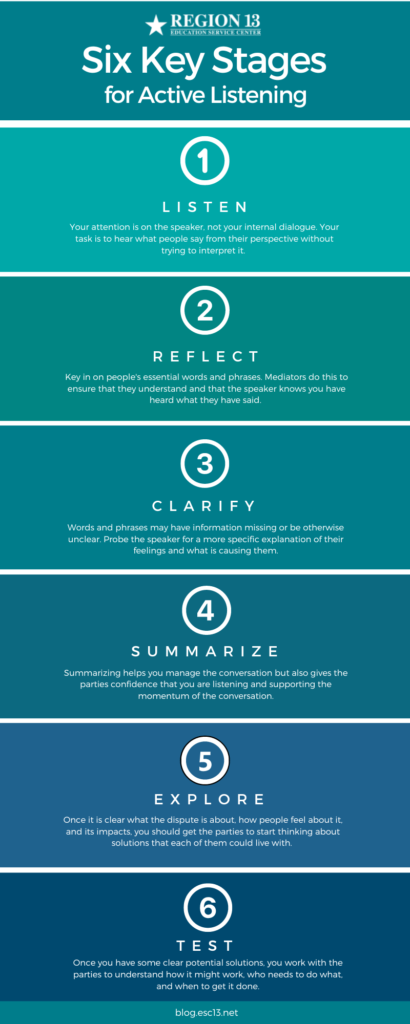The role of the mediator is to help others resolve their problems in a mutually agreeable way without getting bogged down in the problem themselves.
Peer mediation adds value, directly impacts the campus in the hallways and lunchrooms, restores friendships, and equips young people with skills they can use with their families and friends. As these students become adults, they have these necessary mediation skills.
One essential tool in peer mediation is active listening, which helps young people resolve conflicts. But before we dive into that skill, let’s explore peer mediation programs.
What are Peer Mediation Programs?
Conflicts will naturally occur. Peer mediation programs seek to teach students to become mediators and encourage them to constructively solve problems, such as bullying and aggression (McWilliam, 2010).
Schools that implement a peer mediation program may find that it serves as an alternative approach to traditional punitive and exclusionary discipline practices by reducing the number of conflicts resulting in aggression. Students may also be more empowered by the peer mediation system. This way, they can express input and have a voice in the mediation process rather than having discipline imposed upon them (Sellman, 2011). Mediation, rather than exclusionary discipline, may also encourage school engagement for at-risk students (McWilliam, 2010).
But where do you start? Train a team of students and teachers about skills needed in conflict resolution, beginning with active listening.
ESC Region 13 offers a Peer Mediation training that focuses on Active Listening.
Email Lisette Castaneda for more information!
Active Listening Skills
Although we are expected to “listen” to the other side in a disagreement, many students are not taught how to truly understand what the other person is saying. That’s why it is essential to teach active listening skills. Here are some characteristics of what active listening actually is:
- Questioning and clarifying skills to grasp both the facts and the areas of controversy.
- Emotional intelligence to understand the underlying emotions.
- Summarizing skills to set out the main points of controversy and underlying emotions and help the participants re-frame issues in less emotive language.
- Empathy to help each party to stand in each other’s shoes and understand each other’s point of view.
The Six Key Stages for Active Listening
Active listening progresses through six key stages- listening, reflecting, clarifying, summarizing, exploring, and testing. Let’s look at each step in more detail.

Listen – Your attention is on the speaker, not your internal dialogue. Your task is to hear what people say from their perspective without trying to interpret it. This is tricky, as we often interpret what we hear and respond accordingly.
Reflect– key in on people’s essential words and phrases. Mediators do this to ensure that they understand and that the speaker knows you have heard what they have said.
Clarify – Words and phrases may have information missing or be otherwise unclear. For example, someone might say, “I am very unhappy with how X is behaving.” You need to clarify what they mean by unhappy and find out what behavior X displays that causes this unhappiness.
Summarize – Every now and again, you need to summarize what people have said. This helps you manage the conversation but also gives the parties confidence that you are listening and supporting the momentum of the conversation. You can also reflect on or summarize the behaviors of the parties – in a descriptive way. For example, “I notice that whenever we talk about Y, both of your voices rise, but I am unclear about why yet. Can you tell me?”
Explore – Once it is clear what the dispute is about, how people feel about it, and its impacts, you should get the parties to start thinking about solutions that each of them could live with.
Test – Once you have some clear potential solutions, you work with the parties to understand how it might work, who needs to do what, and when to get it done.
Finally, active listening is one of the critical skills in conflict resolution that demonstrates profound respect. Teaching student mediators how to use this tool can benefit your classroom and set them up for success.
Lisette is a Behavior Specialist and Facilitative Mediator here at ESC Region 13.






Add comment